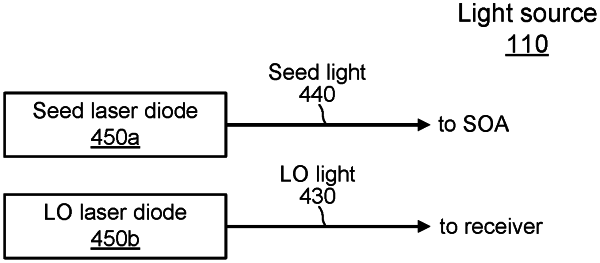| CPC G01S 7/4865 (2013.01) [G01S 7/4814 (2013.01); G01S 7/4818 (2013.01); G01S 7/484 (2013.01); G01S 17/10 (2013.01); G01S 17/89 (2013.01); G01S 7/4816 (2013.01); G01S 7/4817 (2013.01); G01S 7/497 (2013.01); G01S 17/02 (2013.01)] | 33 Claims |

|
1. A lidar system comprising:
a light source configured to emit (i) local-oscillator light and (ii) pulses of light, wherein each emitted pulse of light is coherent with a corresponding portion of the local-oscillator light, and the light source comprises:
a local-oscillator laser diode configured to produce the local-oscillator light, wherein the local-oscillator light comprises continuous-wave light;
a seed laser diode configured to produce seed light, wherein the seed light comprises continuous-wave light; and
a pulsed optical amplifier configured to amplify a temporal portion of the seed light to produce an emitted pulse of light of the emitted pulses of light;
a receiver configured to detect the local-oscillator light and a received pulse of light, the received pulse of light comprising light from the emitted pulse of light that is scattered by a target located a distance from the lidar system, wherein:
the local-oscillator light and the received pulse of light are coherently mixed together at the receiver; and
the receiver comprises:
an optical polarization element configured to alter a polarization of the local-oscillator light to allow the local-oscillator light and the received pulse of light to be coherently mixed together;
a detector configured to produce a photocurrent signal corresponding to the coherent mixing of the local-oscillator light and the received pulse of light; and
a pulse-detection circuit configured to determine, based at least in part on the photocurrent signal, a time-of-arrival for the received pulse of light; and
a processor configured to determine the distance to the target based at least in part on the time-of-arrival for the received pulse of light.
|